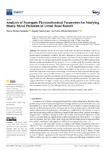Mostrar o rexistro simple do ítem
Analysis of surrogate physicochemical parameters for studying heavy metal pollution in urban road runoff
| dc.contributor.author | Jiménez Fernández, Vicente | |
| dc.contributor.author | Suárez-López, Joaquín | |
| dc.contributor.author | Zafra Mejía, Carlos Alfonso | |
| dc.date.accessioned | 2023-03-17T17:23:15Z | |
| dc.date.available | 2023-03-17T17:23:15Z | |
| dc.date.issued | 2023 | |
| dc.identifier.citation | Jiménez-Fernández, V.; Suárez-López, J.; Zafra-Mejía, C.A. Analysis of Surrogate Physicochemical Parameters for Studying Heavy Metal Pollution in Urban Road Runoff. Water 2023, 15, 85. https://doi.org/10.3390/w15010085 | es_ES |
| dc.identifier.uri | http://hdl.handle.net/2183/32714 | |
| dc.description | Este artigo forma parte do número especial "Urban hydrology and sustainable drainage system" | es_ES |
| dc.description.abstract | [Abstract:] The pollution associated with road runoff water can generate significant impacts on the receiving natural environment due to the significant masses mobilized under certain climate, morphological, and anthropic conditions. The aim of this paper is to show an analysis of the possible surrogate conventional physicochemical parameters of pollution by heavy metals (HMs) in urban road runoff. The best surrogate physicochemical parameters are detected by a differentiated analysis between the HM concentrations (Fe, Al, As, Ba, Cd, Co, Cu, Cr, Mn, Hg, Ni, Pb, V, and Zn) in the total, particulate, and dissolved fractions. This analysis is also performed under two scenarios of runoff event energy according to the mobilized TSS load. The results suggested that it was easier to detect surrogate parameters for total HM concentrations during higher-energy runoff events. The outcomes hinted that regardless of the runoff event energy, it was easier to detect conventional surrogate parameters for the particulate HM concentration compared to the dissolved HM concentration. The findings showed for total HM concentration that the best surrogate parameter during higher-energy runoff events was TSS. The best surrogate HM during these runoff events was Fe. The results also suggested that HMs with high percentages of association with the particulate fraction (>70%) of road runoff were the best surrogates for the other HMs under study. For lower-energy runoff events, the best surrogate parameter was VSS, although TSS also showed good behavior. | es_ES |
| dc.description.sponsorship | Ministerio de Educación y Ciencia; CGL2005-08001/HID | es_ES |
| dc.language.iso | eng | es_ES |
| dc.publisher | MDPI | es_ES |
| dc.relation.uri | https://doi.org/10.3390/w15010085 | es_ES |
| dc.rights | Atribución 3.0 España | es_ES |
| dc.rights.uri | http://creativecommons.org/licenses/by/3.0/es/ | * |
| dc.subject | Heavy metal | es_ES |
| dc.subject | Road runoff | es_ES |
| dc.subject | Urban pollution | es_ES |
| dc.subject | Surrogate parameter | es_ES |
| dc.subject | Water quality | es_ES |
| dc.title | Analysis of surrogate physicochemical parameters for studying heavy metal pollution in urban road runoff | es_ES |
| dc.type | info:eu-repo/semantics/article | es_ES |
| dc.rights.access | info:eu-repo/semantics/openAccess | es_ES |
| UDC.journalTitle | Water | es_ES |
| UDC.volume | 15 | es_ES |
| UDC.issue | 1 | es_ES |
| UDC.startPage | 85 | es_ES |
| dc.identifier.doi | 10.3390/w15010085 |
Ficheiros no ítem
Este ítem aparece na(s) seguinte(s) colección(s)
-
CITEEC-GEAMA - Artigos [115]






